Extended Development Team: Concept, Benefits, and Hiring Steps Explained
Updated 26 Aug 2023
12 Min
2524 Views
Today, software developers are worth their weight in gold. When planning on software development, companies often try to gather an in-house team of engineers. However, it may be hard to hire the right talents in time. Moreover, an internal development team isn’t a very cost-effective solution for small and mid-size businesses. That’s why around 41% of companies have outsourced software development in 2020.
If you’ve a small engineering department that lacks experience with particular technologies, you can use an extended team model. It lets you reinforce your team with the required talents in the shortest time.
An extended development team can help you in many ways:
- Development process becomes more cost-efficient
- Talents can be found faster
- The project meets all the deadlines
- You can manage the team personally
In this guide, we’ve explained every single detail about the extended team model, its benefits, and the best ways to use it.
Here’s what you’re going to learn:
What Is an Extended Team Model
The extended team model brings together the customer’s in-house developers, and remote specialists from an IT outsourcing company. The extended team can be managed by the client’s employees (project manager, CTO) or by the client personally.
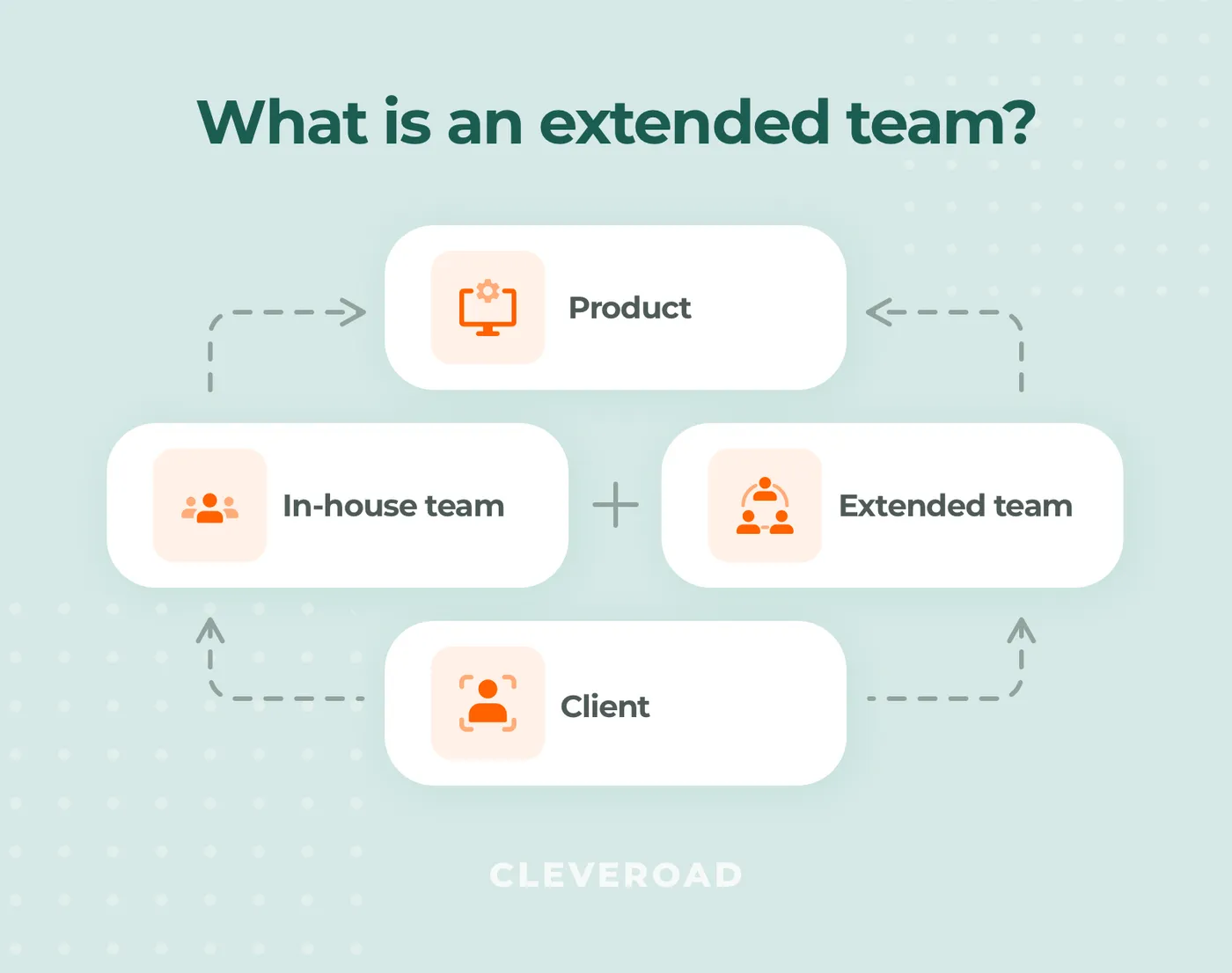
How extended teams work
It’s important to understand that the extended development team supplements your main team. That means you’re paying for talents, not for the A to Z product development. You’ll be responsible for the idea, feature list, product roadmap, and other preparational steps. Developers from the extended team will use their skills to complete the in-house project manager’s tasks.
Check out our guide on types of outsourcing models to find the model that suits you the most.
Let’s assume that you need to develop an e-commerce website. You may have developers with a solid knowledge of web development, but big e-commerce projects are very complex and may require specific expertise that you don’t have in the team. In that case, you’ll need to find engineers that know how to integrate payment gateways or adjust the cloud storage for your business needs. If your in-house developers don’t have the required expertise, an extended team can fill in this gap. Instead of wasting time on headhunting and recruitment, the outsourcing company can assign specialists in a short time.
Unlike other outsourcing models, the extended team model implies that app project management activities happen on the client’s side. In the meantime, remote developers handle assigned tasks and report to in-house project managers or other responsible employees.
In the project-based model, you describe the project idea, business analysts draw up a feature list, and your tech partner is fully responsible for the whole development. The company communicates with you throughout the development and shows a product demo after each sprint (a set amount of work).
Benefits of the Extended Team Model
If you’re thinking over whether to use this outsourcing model for your project or not, you should understand its benefits to the software development process. Let’s single out each advantage of this model.
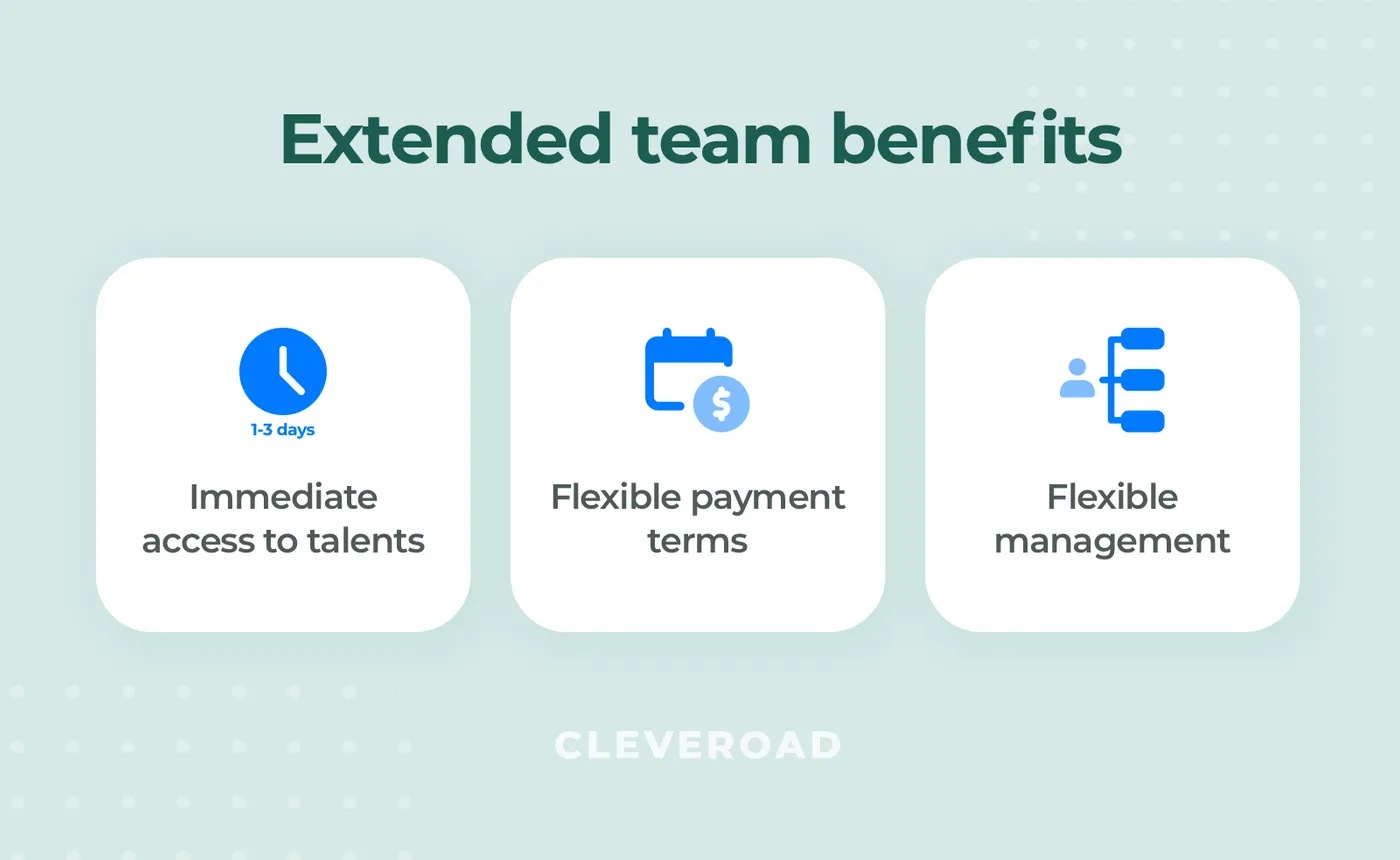
Main benefits of the extended team model
Cost-Effectiveness
A large in-house team of developers may be out of a budget for startups, small and mid-sized businesses. Developers from the US, Western Europe, or Oceania charge the highest rates in the world. According to PayScale, senior software developers in the US charge 64$/hour. Depending on the specialization, developers may charge 100$/hour and over.
However, a single developer, even a highly experienced one, can’t build a project. That’s why you have to gather a team, which obviously costs a lot.
Outsourced developers, in their turn, charge far less. For example, in Ukraine, a well-known outsourcing destination, companies charge $25-$50/hour. Such a price difference leads to a substantial project cost decrease.
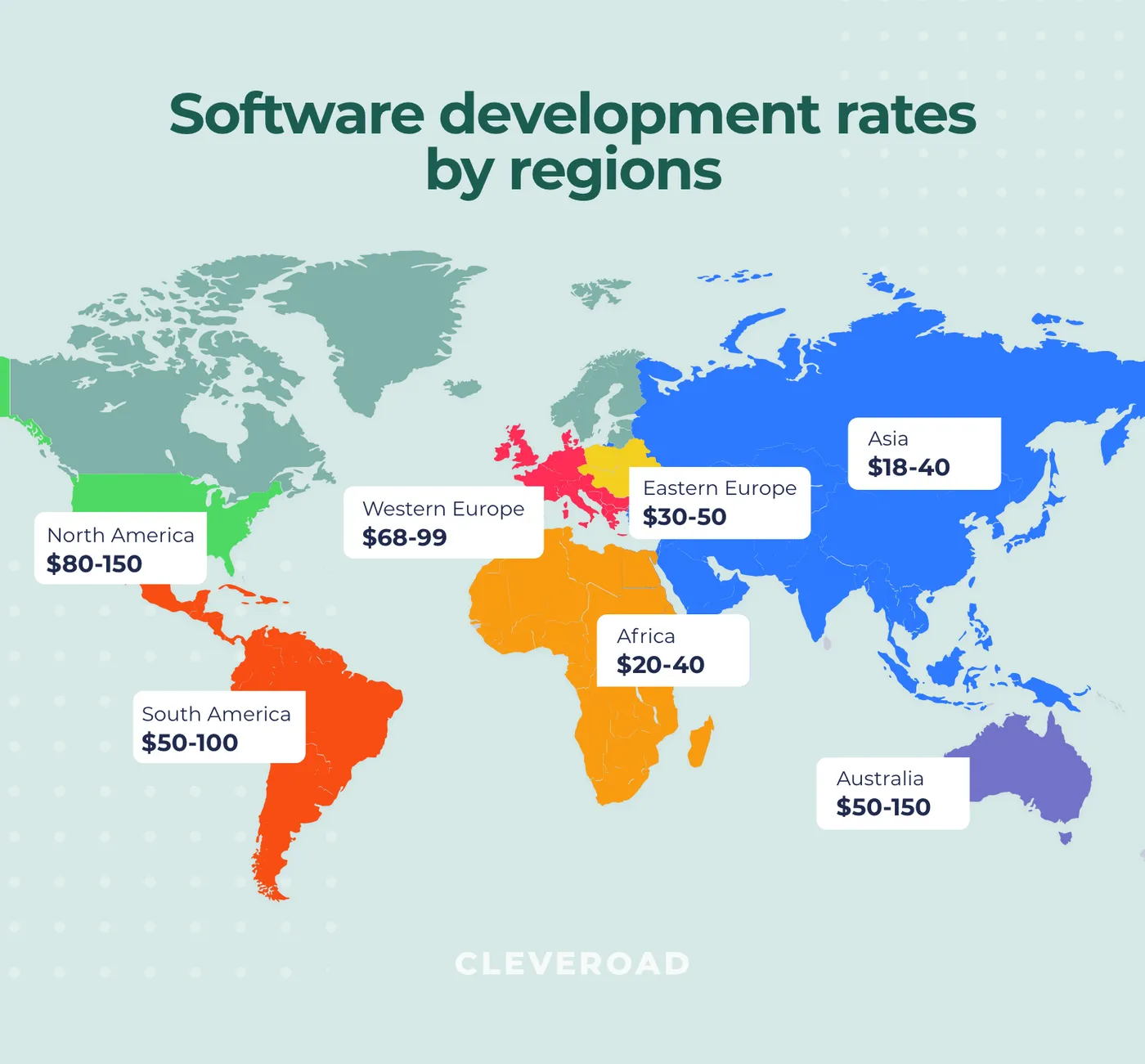
Software development rates by regions
Besides, cooperation with an extended team is temporal. If you need several experienced developers to build a particular feature, you can sign a contract covering only the development period. After the development, remote engineers will leave your in-house team. However, if you hire narrowly focused employees to your office for a particular task, chances are you can’t reassign them to other tasks due to the lack of experience in other niches. That means you’ll have to pay for the talent that you no longer need.
Finally, the extended team model absolves you from operational expenses. Your tech partner provides the extended team with working places, software licenses, and up-to-date hardware. You don’t spend money on additional equipment or to rent a bigger office for new employees.
Hassle-Free Recruiting
In case you already have a team of developers, you know that recruiting IT specialists is an intricate and time-consuming process. Entrepreneurs that hire developers via recruiting agencies pay large fees and often wait for too long.
On the other hand, internal recruitment departments require expensive digital tools to headhunt candidates. Besides, your senior technical specialists should have enough experience to identify the right talents and also spend a lot of time for interviews.
The extended team model saves you from recruitment-related expenses. Your tech partner will find the best talents that match your business requirements. Usually, it doesn’t take more than 1-3 days to get the required candidates to your project. However, the time depends on the number of candidates you need. There’s a significant difference between hiring two iOS developers and a team of 20 developers with knowledge of various technologies. If you need a lot of specialists for the project, the team gathering process may drag on.
Flexibility
Among all outsourcing models, the extended team is the most flexible one. This model can get along with almost every budget. The reason is that you can negotiate with your tech partner about the payment terms.
The extended team model lets you pay salaries weekly, daily, monthly, and in many other ways. You can discuss the payment schedule, installment of payments, and additional perks after the initial meeting. Besides, you can adjust the size of your team in case it exceeds your budget.
Unlike other outsourcing models, extended teams lets you hire the exact number of talents you need. So, if you don’t have enough resources for several senior developers, you can hire middle specialists to supplement your project.
Managing Team in Person
Due to the fact that extended team members are a part of your team, you can manage them on your own. With other outsourcing models, you’ll have to hire a project manager from the vendor’s company that’ll be keeping in touch with you throughout the project. With this model, you can personally assign tasks to each developer and control the development process via project management tools.
In case you don’t have time to deal with team management, you can assign an in-house project manager to work with the remote team. If an extended team doesn’t get enough feedback or assistance in particular situations, they may feel frustration.
How to Make This Model Work?
As we’re clear with the benefits of this model, it’s time to learn how the extended team model works.
Pre-planning
Before contacting the software development company, you should have a clear vision of your software’s concept. The extended team can handle all the technical aspects of the development process, but the product idea falls on the client’s shoulders. It’ll be hard to work remotely when the extended team is unaware of the product they’re working on.
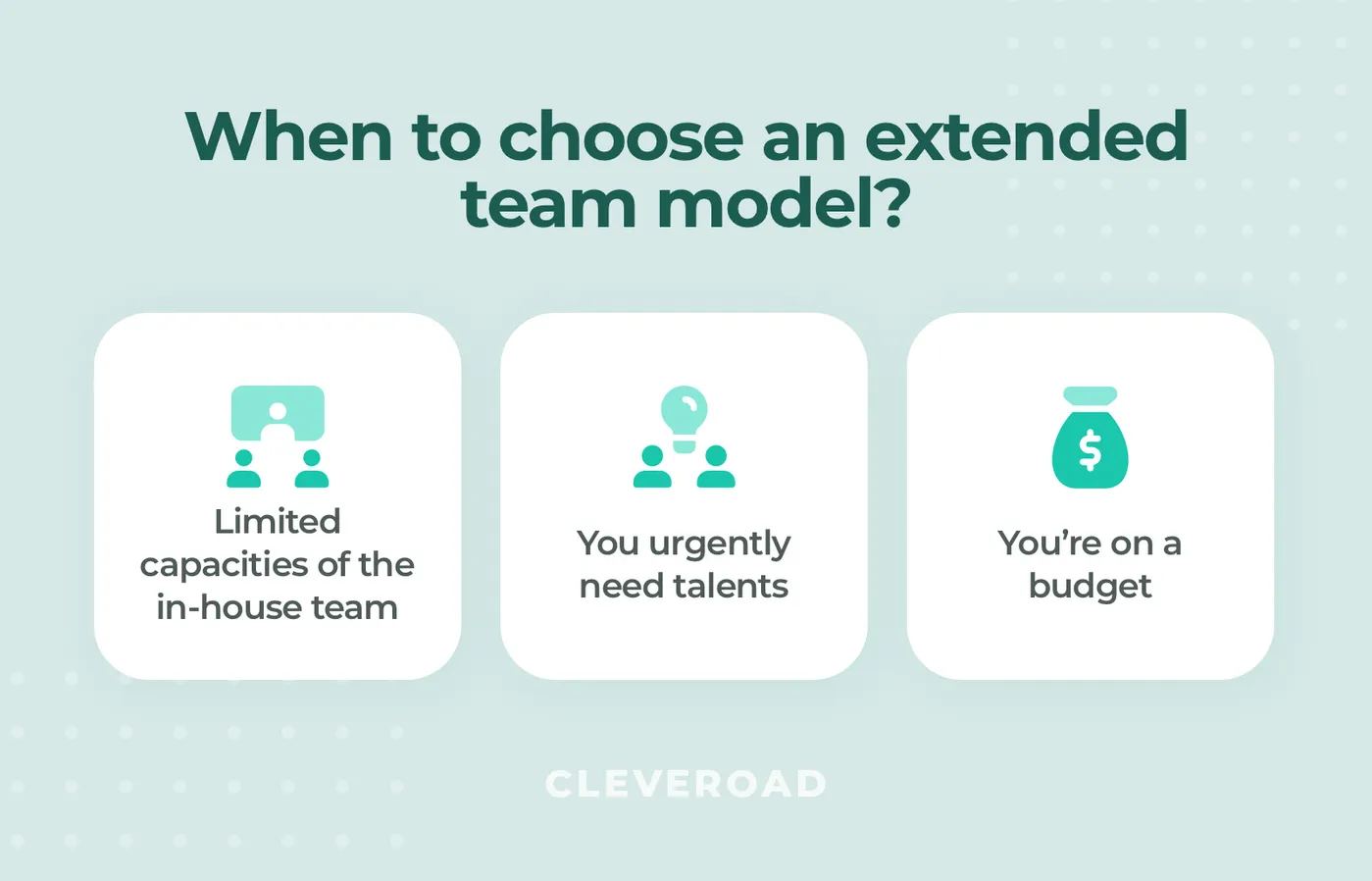
3 reasons to choose an extended team model
On top of that, you should draw up a preliminary feature list with your internal development team. A list of your software’s primary features will help business analysts to understand what kind of talents you need for the project and what experience they should have.
Looking for a Tech Partner
The choice of software development company affects the cost and quality of the final product. Companies from popular outsourcing destinations like Ukraine set reasonable rates for their services and deliver a quality product.
Learn cost to outsource app development to different world regions.
Here are developers’ rates and additional stats from some of the most popular outsourcing destinations:
To find a reliable software development company, you can use platforms that provide information about IT vendors and display reviews from real clients.
Here’s the list of the most popular platforms where you can find a team:
- Clutch. Clutch is a well-known platform that has information about various software development vendors. Here you can access data about company size, minimal project price, location, and so on. In the description, businesses always specify types of services they provide like iOS development, cloud architecture, extended teams, and so on. Additionally, you can check clients’ reviews and the position in the global ranking.
- GoodFirms. GoodFirms is another platform that helps companies to make the right decision. It has in-built filters that divide IT companies according to their specialty. The platform also creates statistical reports about different fields and industries.
- IT Firms. Here, you can find lists with the best software developers in different regions. You can use IT Firms to exclude weak candidates and find the best extended team for your project.
Searching for a tech partner?
We have extensive experience in assembling extended teams and can find developers that match your project.
Assembling a Team
After you’ve contacted the company, business analysts will arrange an online meeting with you to clear up your business requirements. The primary task here is to identify the technical aspects of the project. Analysts gather an extended team based on the feature list, your current team, and your expectations. However, it’s very important to catch the team spirit and allocate specialists that’ll complement the team not only technically but also mentally and emotionally.
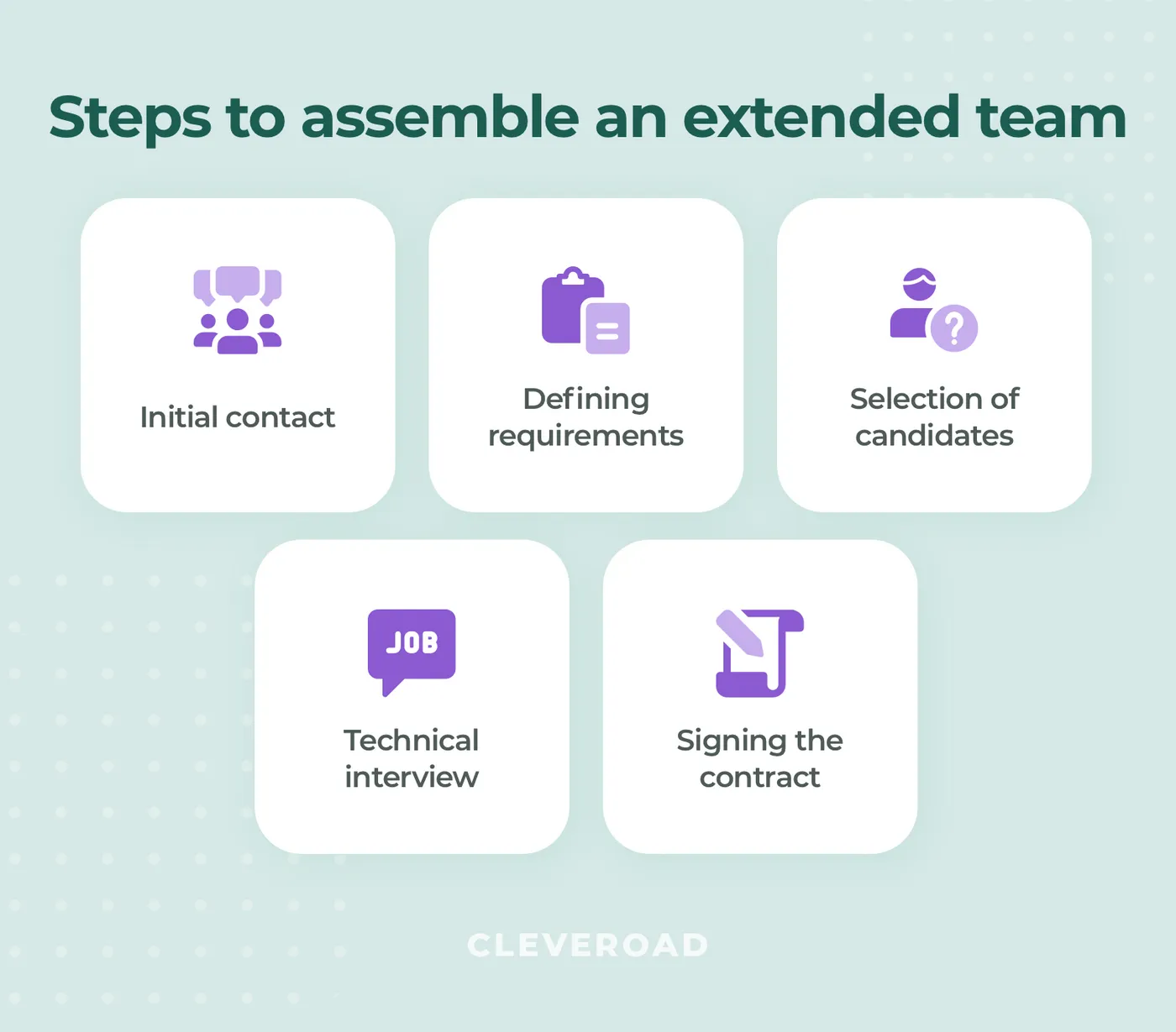
5 steps to assemble an extended team
Not every programmer can be a part of the extended development team. Remote engineers should know how to solve tasks on their own and meet all the deadlines. Besides, extended team members need an advanced level of English to communicate with the in-house team, project managers, and clients.
Usually, companies allocate middle and senior developers for extended teams. Sometimes, businesses need to know what is a solutions architect that offers tech ideas and supervises the development process.
Junior specialists aren’t popular with this model because they need more time to integrate into the project and figure out the tech stack. When it comes to your money and development time, it’s better to hire experienced employees.
After the meeting, business analysts pass all the information to resource managers. They search for employees that’d be the best fit for this project.
When the team sample is ready, you review programmers’ CVs with information about their experience, previous projects, and roles on the project. If everything suits your needs, you can arrange a technical interview. Sometimes, clients arrange several interviews:
- Technical interview with the development team and CTO
- Organizational interview with CEO or product owner
Finally, when all the aspects match your expectations, you can sign the contract with the company.
Team Onboarding
After the extended team line-up's approval, you need to establish a communication bridge between remote and in-house developers. If your remote employees have some development issues, they need to seamlessly reach out to the in-house team. Apps for corporate messaging are the best option for communication between employees. Your engineers can create groups, channels, make audio or video calls, and integrate with project management tools inside the workspace. From our experience, we can recommend Slack. It has a convenient interface and versions for all popular platforms, including the web version.
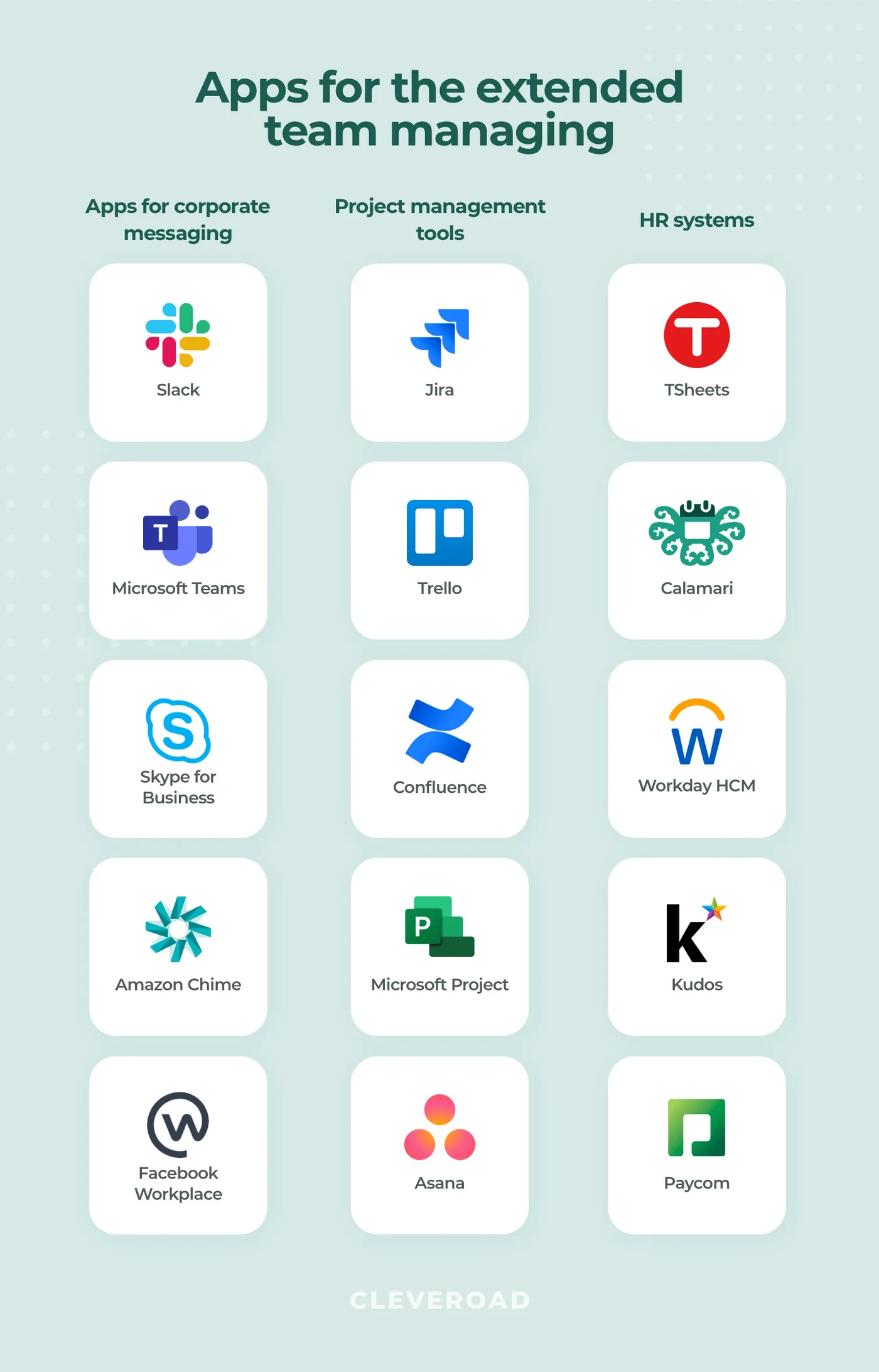
3 main types of project management tools (with examples)
To adjust the team’s work, you should grant access to project management tools. Jira and Trello help developers to track their tasks, log the time spent on each task, and monitor the progress of the whole project. These tools are an integral part of agile software development methodology, which accelerates projects significantly.
Don’t forget that your remote employees might get sick or need a day off. Take care of their personal accounts in your HR system. Thus, your engineers will be able to inform HRs about their absence, make different requests, and recall all organizational details with the help of an HR guide.
Define Clear Goals
As your extended team is ready to work, the last remaining point is to set clear project requirements. Each member of the extended team should understand their role, individual tasks, and deadlines.
If you can’t clearly explain the remote developers’ role in the project, it may lead to confusion during the development and raise the time required to launch the product.
To control your employees’ performance, you can set KPIs. Clear performance indicators will help developers realize whether they’re moving in the right direction or they need to change the development approach completely.
Beginning of the Development
When the team is assembled and all the questions are settled, the development process begins. From now on, the main task is to monitor and manage the extended team, addressing all issues that happen during the process.
How It Works at Cleveroad
Here, at Cleveroad, we know how to assemble effective and flexible extended teams. We have a wide choice of engineers with expertise in up-to-date technologies across all popular platforms. Our specialists are fluent in English, so they don’t have any communicational issues while working with remote teams. Besides, our extended team developers always get support from their colleagues working on other projects. A friendly environment facilitates fast problem-solving.
We’ve delivered more than 150 successful projects, both for startups and large corporations. One of them was Blockbuster, a Nordic video-on-demand platform. Blockbuster was an iconic video and gaming rental company. Later a top-tier Danish telecommunications provider purchased its brand rights and launched a streaming platform for Nordic countries.
We’ve gathered an extended team that upgraded Blockbuster’s iOS and Android apps. Here’s a review from Blockbuster’s CTO, Henrik Loop:
Henrik Loop's review
Looking for an extended team?
Our experienced specialists are ready to build your project. Contact us to learn more about our talent pool.
The extended team model brings together the customer’s in-house developers, and remote specialists from an IT outsourcing company. The extended team can be managed by the client’s employees (project manager, CTO) or by the client personally.
To find additional developers in the shortest terms you can use the extended team model. It allows entrepreneurs to merge their in-house team with the remote team provided by the vendor.
There are several benefits of the extended team model:
- Cost-effectiveness
- Hassle-free recruiting
- Flexibility
- Personal management of the team
To find a software development company that will find the appropriate developers for you, you can use the following services:
- Clutch
- GoodFirms
- IT Firms
All of these platforms contain detailed description about software development companies that gather extended teams.
There are several steps to assemble the dedicated team:
- Initial contact
- Defining requirements
- Selection of candidates
- Technical interview
- Signing the contract
Tools for managing extended teams should include communication tools, project management tools and HR systems. Slack is the best corporate messenger for remote teams. As for the project management tools, you can use Trello or Jira. Finally, we recommend Calamari and TSheets for HR processes.

Evgeniy Altynpara is a CTO and member of the Forbes Councils’ community of tech professionals. He is an expert in software development and technological entrepreneurship and has 10+years of experience in digital transformation consulting in Healthcare, FinTech, Supply Chain and Logistics
Give us your impressions about this article
Give us your impressions about this article